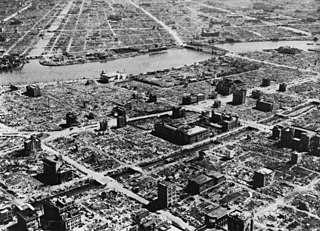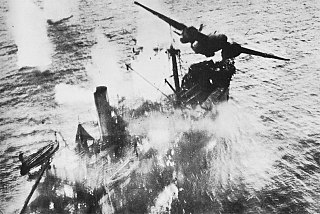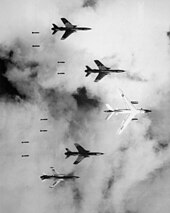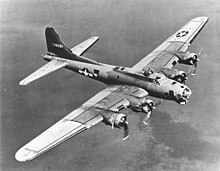
A bomber is a military combat aircraft designed to attack ground and naval targets by dropping air-to-ground weaponry, launching torpedoes, or deploying air-launched cruise missiles. The first use of bombs dropped from an aircraft occurred in the Italo-Turkish War, with the first major deployments coming in the First World War and Second World War by all major airforces causing devastating damage to cities, towns, and rural areas. The first purpose built bombers were the Italian Caproni Ca 30 and British Bristol T.B.8, both of 1913. Some bombers were decorated with nose art or victory markings.

Strategic bombing is a military strategy used in total war with the goal of defeating the enemy by destroying its morale, its economic ability to produce and transport materiel to the theatres of military operations, or both. It is a systematically organized and executed attack from the air which can utilize strategic bombers, long- or medium-range missiles, or nuclear-armed fighter-bomber aircraft to attack targets deemed vital to the enemy's war-making capability. The term terror bombing is used to describe the strategic bombing of civilian targets without military value, in the hope of damaging an enemy's morale.

An interceptor aircraft, or simply interceptor, is a type of fighter aircraft designed specifically for the defensive interception role against an attacking enemy aircraft, particularly bombers and reconnaissance aircraft. Aircraft that are capable of being or are employed as both ‘standard’ air superiority fighters and as interceptors are sometimes known as fighter-interceptors. There are two general classes of interceptor: light fighters, designed for high performance over short range; and heavy fighters, which are intended to operate over longer ranges, in contested airspace and adverse meteorological conditions. While the second type was exemplified historically by specialized night fighter and all-weather interceptor designs, the integration of mid-air refueling, satellite navigation, on-board radar and beyond visual range (BVR) missile systems since the 1960s has allowed most frontline fighter designs to fill the roles once reserved for specialised night/all-weather fighters.

A light bomber is a relatively small and fast type of military bomber aircraft that was primarily employed before the 1950s. Such aircraft would typically not carry more than one ton of ordnance.

Firebombing is a bombing technique designed to damage a target, generally an urban area, through the use of fire, caused by incendiary devices, rather than from the blast effect of large bombs.

The Avro Lancaster is a British Second World War heavy bomber. It was designed and manufactured by Avro as a contemporary of the Handley Page Halifax, both bombers having been developed to the same specification, as well as the Short Stirling, all three aircraft being four-engined heavy bombers adopted by the Royal Air Force (RAF) during the same era.

A dive bomber is a bomber aircraft that dives directly at its targets in order to provide greater accuracy for the bomb it drops. Diving towards the target simplifies the bomb's trajectory and allows the pilot to keep visual contact throughout the bomb run. This allows attacks on point targets and ships, which were difficult to attack with conventional level bombers, even en masse.

A strategic bomber is a medium- to long-range penetration bomber aircraft designed to drop large amounts of air-to-ground weaponry onto a distant target for the purposes of debilitating the enemy's capacity to wage war. Unlike tactical bombers, penetrators, fighter-bombers, and attack aircraft, which are used in air interdiction operations to attack enemy combatants and military equipment, strategic bombers are designed to fly into enemy territory to destroy strategic targets. In addition to strategic bombing, strategic bombers can be used for tactical missions. There are currently only three countries that operate strategic bombers: the United States, Russia and China.

An airstrike, air strike, or air raid is an offensive operation carried out by aircraft. Air strikes are delivered from aircraft such as blimps, balloons, fighter aircraft, attack aircraft, bombers, attack helicopters, and drones. The official definition includes all sorts of targets, including enemy air targets, but in popular usage the term is usually narrowed to a tactical (small-scale) attack on a ground or naval objective as opposed to a larger, more general attack such as carpet bombing. Weapons used in an airstrike can range from direct-fire aircraft-mounted cannons and machine guns, rockets and air-to-surface missiles, to various types of aerial bombs, glide bombs, cruise missiles, ballistic missiles, and even directed-energy weapons such as laser weapons.

Aerial warfare is the use of military aircraft and other flying machines in warfare. Aerial warfare includes bombers attacking enemy installations or a concentration of enemy troops or strategic targets; fighter aircraft battling for control of airspace; attack aircraft engaging in close air support against ground targets; naval aviation flying against sea and nearby land targets; gliders, helicopters and other aircraft to carry airborne forces such as paratroopers; aerial refueling tankers to extend operation time or range; and military transport aircraft to move cargo and personnel.

The Norden Mk. XV, known as the Norden M series in U.S. Army service, is a bombsight that was used by the United States Army Air Forces (USAAF) and the United States Navy during World War II, and the United States Air Force in the Korean and the Vietnam Wars. It was an early tachometric design that directly measured the aircraft's ground speed and direction, which older bombsights could only estimate with lengthy manual procedures. The Norden further improved on older designs by using an analog computer that continuously recalculated the bomb's impact point based on changing flight conditions, and an autopilot that reacted quickly and accurately to changes in the wind or other effects.
The Pathfinders were target-marking squadrons in RAF Bomber Command during World War II. They located and marked targets with flares, which a main bomber force could aim at, increasing the accuracy of their bombing. The Pathfinders were normally the first to receive new blind-bombing aids like Gee, Oboe and the H2S radar.

Toss bombing is a method of bombing where the attacking aircraft pulls upward when releasing its bomb load, giving the bomb additional time of flight by starting its ballistic path with an upward vector.

A bombsight is a device used by military aircraft to drop bombs accurately. Bombsights, a feature of combat aircraft since World War I, were first found on purpose-designed bomber aircraft and then moved to fighter-bombers and modern tactical aircraft as those aircraft took up the brunt of the bombing role.
Ground-directed bombing (GDB) is a military tactic for airstrikes by ground-attack aircraft, strategic bombers, and other equipped air vehicles under command guidance from aviation ground support equipment and/or ground personnel. Often used in poor weather and at night, the tactic was superseded by an airborne computer predicting unguided bomb impact from data provided by precision avionics Equipment for radar GDB generally included a combination ground radar/computer/communication system and aircraft avionics for processing radioed commands.

Skip bombing was a low-level bombing technique independently developed by several of the combatant nations in World War II, notably Italy, Australia, Britain, Soviet Union and the United States. It allows an aircraft to attack shipping by skipping the bomb across the water like a stone. Dropped at very low altitudes, the bomb never rises more than about 5 metres (16 ft) above the surface of the water, ensuring that it will hit the side of the ship as long as it is aimed correctly.

The Stabilised Automatic Bomb Sight (SABS) was a Royal Air Force bombsight used in small numbers during World War II. The system worked along similar tachometric principles as the more famous Norden bombsight, but was somewhat simpler, lacking the Norden's autopilot feature.

The Mark XIV Bomb Sight was a bombsight developed by Royal Air Force (RAF) Bomber Command during the Second World War. It was also known as the Blackett sight after its primary inventor, P. M. S. Blackett. Production of a slightly modified version was also undertaken in the United States as the Sperry T-1, which was interchangeable with the UK-built version. It was the RAF's standard bombsight for the second half of the war.

The Defence of the Reich is the name given to the strategic defensive aerial campaign fought by the Luftwaffe of Nazi Germany over German-occupied Europe and Germany during World War II. Its aim was to prevent the destruction of German civilians, military and civil industries by the Western Allies. The day and night air battles over Germany during the war involved thousands of aircraft, units and aerial engagements to counter the Allied strategic bombing campaign. The campaign was one of the longest in the history of aerial warfare and with the Battle of the Atlantic and the Allied Blockade of Germany was the longest of the war. The Luftwaffe fighter force defended the airspace of German-occupied territory against attack, first by RAF Bomber Command and then against the United States Army Air Forces (USAAF) in the Combined Bomber Offensive.

Wilde Sau was the term given by the Luftwaffe to the tactic used from 1943 to 1944 during World War II by which British night bombers were engaged by single-seat day-fighter aircraft flying in the Defence of the Reich.




















